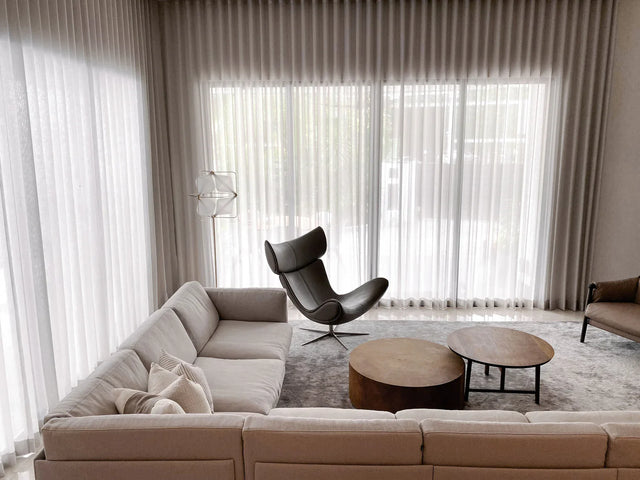The Art of Layering: How to Mix Textures for a Luxurious Home
Layering textures is one of the most effective ways to bring depth, warmth, and personality into an interior space. From tactile materials like linen and velvet to thoughtful pairings of sheer and heavyweight fabrics, mixing textures transforms a home's visual and tactile experience.
It’s not just about aesthetics — it’s about crafting an atmosphere that feels curated, cohesive, and comfortable. Whether it’s a gauzy curtain next to a plush rug, or crisp cotton paired with soft wool, the right combination of materials adds richness and a sense of lived-in luxury.
Why Layering Matters in Interior Design
Layering in interior design goes beyond placing a throw on a sofa or adding a rug under a table. It’s about combining contrasting yet complementary elements to build visual richness and tactile appeal. Natural fibres like linen, cotton, wool, and silk all bring distinct textures — linen is crisp and breathable, wool is soft and plush, silk adds sheen, and velvet introduces opulence. When layered thoughtfully, these materials create an immersive sensory experience.
Soft furnishings, in particular, play a central role. A rug like the abbey lane handknotted alpaca wool, paired with a linen-upholstered chair and a velvet cushion creates a dynamic mix of finishes. These combinations help break the monotony of flat surfaces and smooth finishes, turning a simple layout into a multidimensional space. More than that, texture can subtly direct the mood — cool and calm with airy fabrics, warm and grounded with heavier weaves.
Layering with Curtains and Drapes
Curtains are one of the easiest and most impactful ways to layer texture in a room. Start with a base layer: sheer curtains made of linen or organic cotton can soften natural light and lend a delicate touch to your windows. These sheers offer daytime privacy while creating a gentle, glowing ambience.
Layering on heavier drapes — such as blackout-lined curtains made from velvet or blended natural fibres — adds substance and function. These provide light control, privacy, and a sense of enclosure for a cosier environment. Visually, the juxtaposition of a translucent sheer with a denser drape adds depth and rhythm to a space.
Each curtain layer also introduces a new texture, contributing to the overall sensory experience. For example, pairing Aratamete’s organic cotton sheers with their luxurious blackout drapes not only enhances light control but also creates a refined, elegant framing for your room.
H3 Mixing and Matching Soft Furnishings
Beyond curtains, layering comes to life through rugs, throws, and upholstery. The key is balance — too many heavy textures can overwhelm a room, while too few can make it feel unfinished. Start by anchoring the space with a foundational texture, such as a wool or flat woven rug. Then build upwards with furniture upholstery in natural fabrics like cotton or linen. Tufted carpets, in particular, introduce a rich, cushioned texture that enhances both visual appeal and tactile comfort.
Then build upwards with furniture upholstery in natural fabrics like cotton or linen. Add cushions in varied materials — perhaps a velvet bolster alongside a wool-knit throw cushion. Don’t shy away from playing with pattern and pile height; the interplay of smooth versus nubby, matte versus shiny, gives the room its character.
Throws can be casually draped over the side of a chair or the edge of a bed, bringing in a relaxed and layered look. Aratamete’s curated selection of soft furnishings makes this kind of thoughtful layering accessible, offering a wide variety of weights, finishes, and tactile elements.
Creating a Harmonious Colour Palette
While texture brings interest, colour ties everything together. Layering different shades within the same colour family can build a sense of calm cohesion. For instance, layering cream, sand, and taupe can create a warm neutral scheme with plenty of dimension — one of the most effective interior design tips for building harmony in a room.
For those who prefer bolder palettes, mixing deep jewel tones — like emerald, navy, and terracotta — can add drama, especially when paired with rich textures like velvet or embroidered cotton. Contrast is also powerful: pairing soft pastels with darker hues, or mixing warm and cool tones, can bring a dynamic edge to your styling.
To maintain balance, follow the 60-30-10 rule: 60% dominant colour, 30% secondary, and 10% accent.
Finishing Touches: Bringing It All Together
Layering textures isn’t just a design trend — it’s a timeless approach to creating luxurious-looking homes that feel comfortable, curated, and personal. From gauzy sheers and plush rugs to upholstered seating and soft throws, every piece plays a role in shaping your home aesthetics.
With Aratamete’s diverse range of soft furnishings crafted from premium, high-quality materials, you can experiment with texture and tone confidently. Whether you’re styling a quiet corner or an entire home, layering offers endless possibilities to elevate the everyday into something beautifully intentional.
